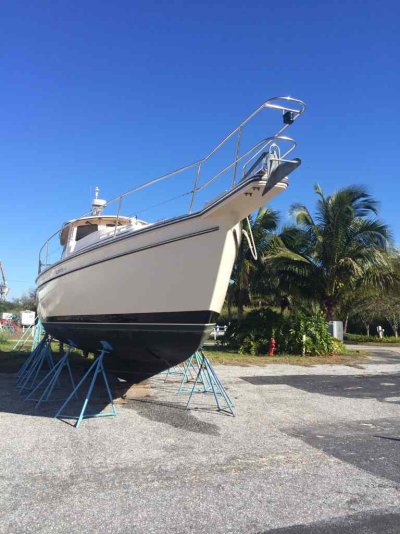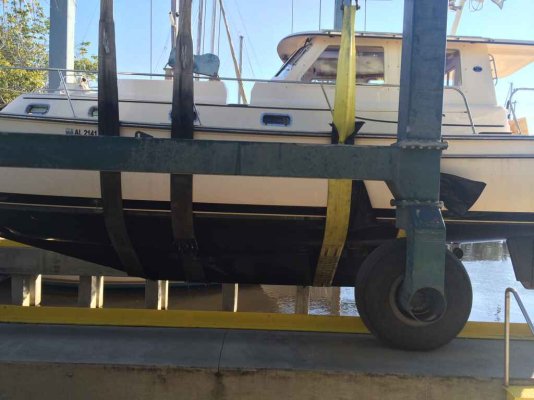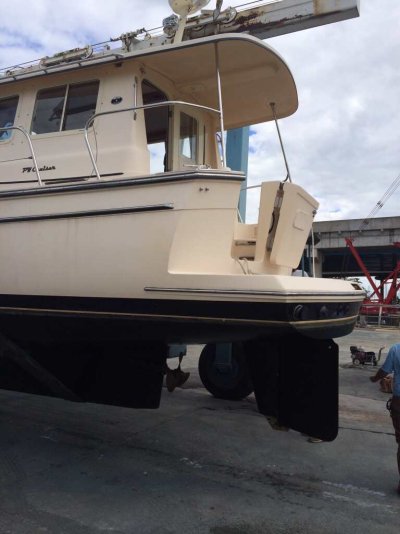Nick14
Guru
JT, I think there is a wider range in SD hull designs than any other (FD or planning) form - there seem to be an almost infinite number of variations, with a resulting wide variation in the performance of the "SD" boat as a result. From "lobster boats", to penetrating hulls, to the Mediterranean Llaut design, to Lynn Senour's take on it, there seem to be a lot of ways to get to "SD" performance. The resulting boats also run the gamut from being near-FD, to near-FP (full planning), to splitting the difference. There are so many factors, the wetted area, the form presented to oncoming waves, center of gravity, it seems as much art as it is science.
With the American Tug (I've owned two, a 34 and current 39), we find that the hull form provides tremendous resistance to rolling - at SD speeds. We've been out in 6-8 ft seas (the worst we've been out in were 10 ft swells) on multiple occasions, and at 10-13 kts, the ride is like a train on rails. It just doesn't roll, or pound, at all.
Though, at higher speeds (14+ kts) in those same conditions, there is more both rolling, and a sense of impact (not pounding, but on the spectrum towards it) in short, steep chop. As speed increases on the Lynn Senour design, more of the hull raises out of the water, and it takes on some of the characteristics of a FP design. At FD speeds in those conditions there is no pounding, but there is rolling, as the hull form doesn't generate enough lateral stability at pure FD speed. For this hull, we've found the best sea-keeping abilities to be in the 10-13 kt "SD" range. The performance of a different "SD" design would likewise differ (as apparently did yours).
Conrad, it's not surprising that our experiences are very similar. Both the Nordic and American Tug hulls were designed by Lynn Senour. I suspect our hulls are extremely similar both below and above the waterline.
For us, having been working full-time until recently, the option for higher speed was necessary if we wanted to actually get someplace out of sight of our home marina in the limited time of a weekend....
With the American Tug (I've owned two, a 34 and current 39), we find that the hull form provides tremendous resistance to rolling - at SD speeds. We've been out in 6-8 ft seas (the worst we've been out in were 10 ft swells) on multiple occasions, and at 10-13 kts, the ride is like a train on rails. It just doesn't roll, or pound, at all.
Though, at higher speeds (14+ kts) in those same conditions, there is more both rolling, and a sense of impact (not pounding, but on the spectrum towards it) in short, steep chop. As speed increases on the Lynn Senour design, more of the hull raises out of the water, and it takes on some of the characteristics of a FP design. At FD speeds in those conditions there is no pounding, but there is rolling, as the hull form doesn't generate enough lateral stability at pure FD speed. For this hull, we've found the best sea-keeping abilities to be in the 10-13 kt "SD" range. The performance of a different "SD" design would likewise differ (as apparently did yours).
Conrad, it's not surprising that our experiences are very similar. Both the Nordic and American Tug hulls were designed by Lynn Senour. I suspect our hulls are extremely similar both below and above the waterline.
For us, having been working full-time until recently, the option for higher speed was necessary if we wanted to actually get someplace out of sight of our home marina in the limited time of a weekend....







